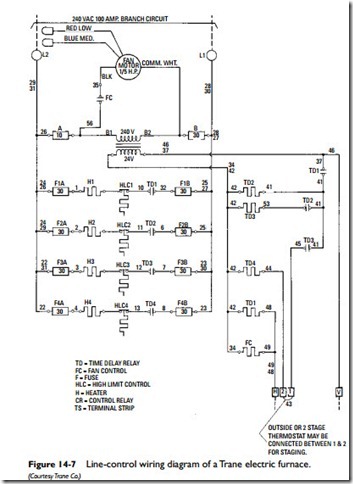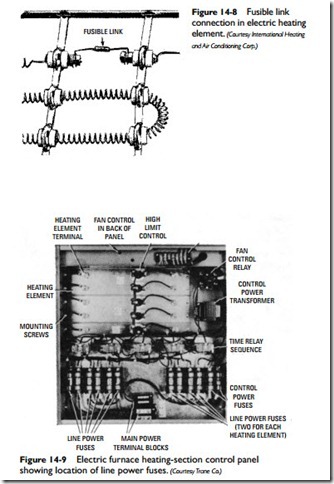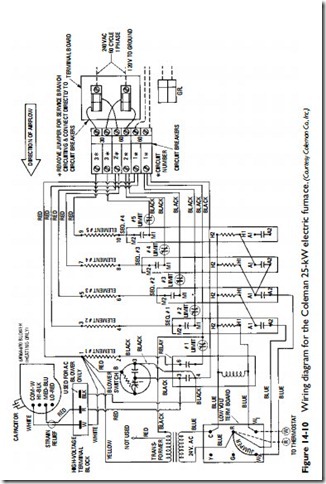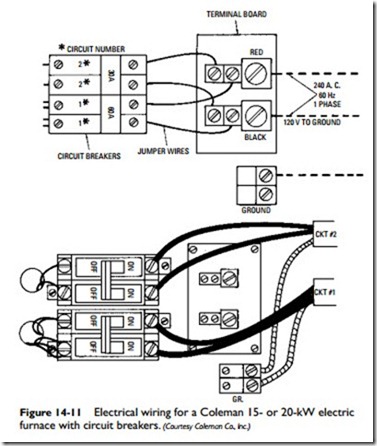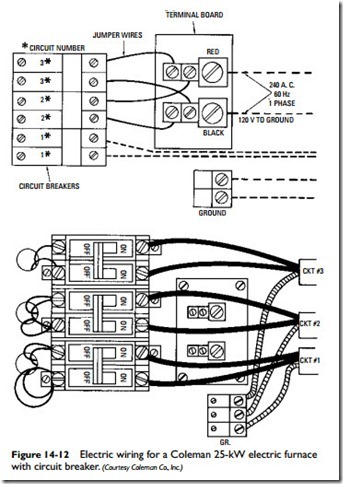Timing Sequences
If all the heating elements in an electric furnace turned on simultaneously, there would be a momentarily excessive demand on the power supply, resulting in a temporary interruption in the electric service. This problem of power drains and surges is eliminated by timing the heating elements so that they start one at a time in pre- determined increments. Sequencers or relays are used for this purpose. In a typcal application the sequencer has a small electric heater powered by the 24-volt control voltage from the thermostat. The control voltage activates a thermo-disk and a timing sequence. The timing sequence is set to a predetermined number of seconds for turning on and off the heating elements. The on-off sequence is also staggered so that the heating elements do not turn on and off all at the same time. The first squencer or relay commonly turns on both the first heating element and the furnace fan.
Safety Controls
Most electric furnaces are equipped with a variety of different safety controls to protect the appliance against current overloading or excessive operating temperatures. These safety controls are:
1. Temperature limit controls
2. Secondary high-limit control
3. Furnace fuses
4. Circuit breakers
5. Control voltage transformer
6. Thermal overload protector
Temperature Limit Controls
In the line control diagram of a Trane EUADH 07A model electric furnace shown in Figure 14-7, each heating element is shown with a high-limit control device located between the heating element and the time-delay relay. These high-limit control devices are designed to limit the outlet air temperature on Trane electric furnaces to 200°F. If the temperature of the outlet air should exceed 200°F, the high-limit control will open and interrupt the supply of electric power to the heating element.
Secondary High-Limit Control
Secondary high-limit protection is provided by a fusible link in each electric heating element (Figure 14-8). This device is designed to shut off the current when temperatures in the furnace become excessive. It functions as a backup system in case of limit switch failure.
Furnace Fuses
Furnace fuses are used to provide protection against possible overload conditions and to ensure correct, safe field wiring. Each heating element circuit is protected by two branch fuses as shown in Figure 14-9. These are sized to limit the current draw of each heater and are designed to open on a short-circuit or an overloaded-circuit condition. For overload protection, the blower motor and relay are also safeguarded with a separate fuse.
Circuit Breakers
Some electric furnaces are equipped with circuit breakers and a terminal board. The wiring diagram for the Coleman 25-kW electric furnace illustrated in Figure 14-10 indicates that both the terminal board and the circuit breakers are located in the power supply feed line to the furnace.
When it is desirable to run branch circuits to the circuit breakers (bypassing the terminal board), the jumper wires between the circuit breakers and the wiring are connected as shown in Figures 14-11 and 14-12.
Transformer
A control voltage transformer is used to limit the amount of output
